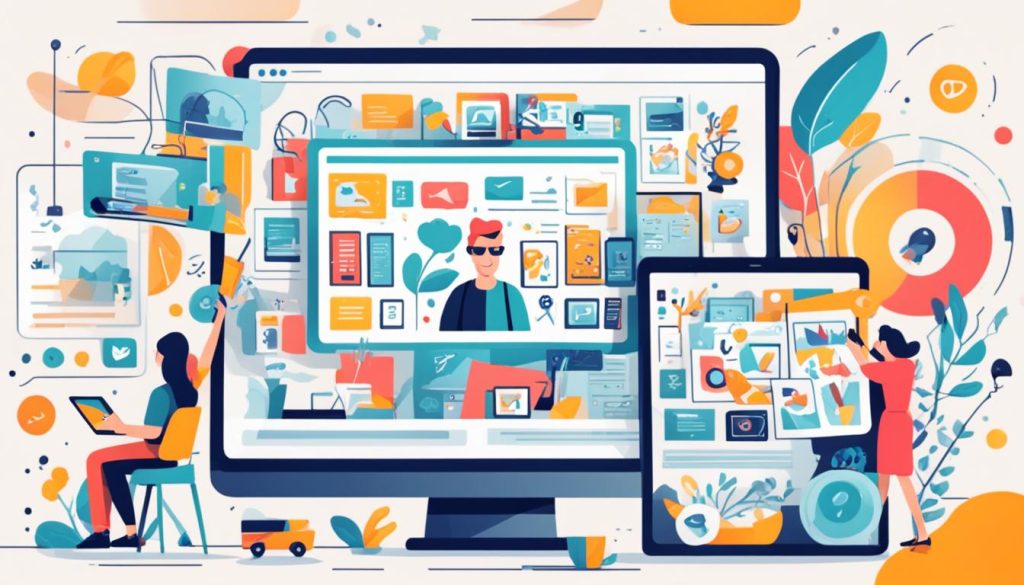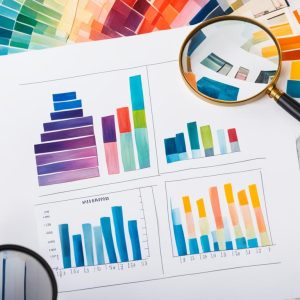Are you an artist looking for ways to generate passive income? While creating art is undoubtedly fulfilling, finding financial stability can sometimes be challenging. Luckily, there are numerous passive income opportunities for artists to explore. These opportunities allow artists to generate revenue consistently, even when they’re not actively creating. In this article, I will share ten passive income ideas that can help artists achieve financial independence and create a sustainable income stream.
Key Takeaways:
- Passive income provides artists with an additional income stream that can generate revenue consistently over time.
- Artists should lay the groundwork and test different passive income streams before expecting high profits.
- Some passive income ideas for artists include affiliate marketing, digital books and guides, physical books, digital art, physical art prints, licensing, online courses, and members-only content.
- Artists should choose passive income streams that align with their skills, interests, and target audience to maximize their earning potential.
- Generating passive income as an artist requires effort and time to set up, but it can lead to long-term financial stability and freedom.
Affiliate Marketing
Affiliate marketing is a powerful and flexible passive income strategy for artists. By becoming an affiliate, artists can promote products they love and earn a commission for each successful sale made through their unique affiliate links. This allows artists to monetize their online presence and share their passion for art while generating income.
One popular niche within affiliate marketing for artists is art supplies. Artists can partner with art supply companies and promote their products on their blogs, social media platforms, and websites. Whether it’s brushes, paints, canvases, or other art materials, artists can provide valuable recommendations and insights to their audience, who in turn may make a purchase through the provided affiliate links.
Amazon, the well-known online marketplace, offers an extensive affiliate program that artists can join. By signing up as an Amazon affiliate, artists gain access to a vast range of products, including art supplies, and earn a commission whenever someone buys a product through their affiliate link. This provides artists with the opportunity to earn passive income without the need to manage inventories or handle shipping logistics.
Affiliate marketing is not limited to traditional websites. Artists can also leverage their blogs or social media platforms to share affiliate links and drive potential customers to make purchases. For example, artists can create engaging blog posts or video tutorials featuring their favorite art supplies and include affiliate links within the content. By providing valuable information and promoting products they genuinely believe in, artists can earn passive income while enhancing their credibility as art influencers.
Advantages of Affiliate Marketing for Artists:
- Minimal effort: Setting up affiliate links requires little time and effort, making it an attractive option for artists looking to generate passive income.
- Diverse revenue streams: Affiliate marketing allows artists to diversify their income streams by promoting a variety of products that align with their interests and audience.
- Flexible promotion methods: Artists can choose how and where to promote affiliate products, whether through blog posts, social media content, or dedicated product reviews.
- No inventory management: Artists don’t need to worry about inventory or shipping logistics, as the companies they partner with handle those aspects.
Affiliate marketing offers artists the opportunity to earn passive income while sharing their passion for art and recommending products they genuinely believe in. By leveraging their online presence, artists can generate additional revenue streams and enhance their financial independence.
“Affiliate marketing allows artists to monetize their online presence and generate passive income while sharing their passion for art.” – [Insert Artist Name]
Next, let’s explore another passive income idea for artists – digital books and guides.
Digital Books and Guides
As an artist, creating and selling digital books and guides can be a lucrative and convenient way to generate passive income. By compiling your knowledge and expertise into downloadable formats, you can reach a wide audience and earn income continuously.
When creating digital books and guides, it is essential to address frequently asked questions and provide valuable insights that your audience will find useful. Consider the topics that resonate with your target market and showcase your unique expertise. Whether it’s a step-by-step guide on a specific art technique or an ebook sharing your personal artistic journey, the key is to provide valuable content that your audience will be willing to pay for.
To ensure a professional and consistent experience for your readers, it’s important to follow a design template throughout your digital books and guides. Consistency in layout, fonts, and visual elements creates a cohesive brand image and enhances the perceived value of your content. Don’t forget to include visually appealing images and illustrations to enhance the overall aesthetic.
It’s also important to update your digital books and guides periodically to maintain their relevance. As technology and trends change, make sure to review and update any links, references, or resources mentioned in your content. This will ensure that your audience continues to find value in your digital downloads and that they remain a reliable source of passive income.
Creating digital books and guides is not only a great way to share your expertise, but it also allows you to establish yourself as an authority in your niche. As your digital library grows, you can attract a loyal following of customers who trust your advice and are willing to invest in your digital products.
Image:
Physical Books
Creating physical books is an exciting opportunity for artists to share their work with a wide audience. Whether they’re art books for fellow artists or whimsical children’s books, physical books allow artists to showcase their creativity in a tangible form.
While writing may not be every artist’s forte, collaborating with talented writers can bring stories to life through captivating illustrations. By teaming up with authors, artists can create visually stunning books on a variety of subjects, from fantasy realms to educational experiences.
One of the benefits of creating physical books is the potential to earn royalties from book sales. By negotiating exclusive licensing agreements, artists can ensure a continuous stream of passive income as their books are purchased and enjoyed by readers.

It’s important to note that upfront payment for illustrations is not considered passive income, as it involves active work. However, through author and illustrator collaborations, artists can establish long-term partnerships and earn ongoing royalties from book sales.
Harnessing the power of physical books allows artists to showcase their talent, expand their reach, and earn a steady income. By immersing readers in captivating visuals and engaging narratives, artists can create a lasting impact with their art.
Digital Art
As an artist, selling digital art can be an excellent way to generate passive income. By exploring online platforms like a second Etsy shop or offering digital downloads as phone and desktop backgrounds, you can tap into a wider market and reach more potential buyers.
When selling digital art, it’s essential to consider the quality of printing. While printing at home may seem convenient, opting for professional printing ensures customer satisfaction and helps maintain the value of your artwork. Professional printing services can deliver high-quality prints that showcase the intricate details and vibrant colors of your digital art.
Additionally, offering downloadable art as digital files provides instant access to your creations. Customers can purchase and download your artwork directly from your online platform, eliminating the need for physical shipping and handling. This convenience appeals to buyers who appreciate instant gratification and prefer a clutter-free living space.
By creating a second Etsy shop dedicated exclusively to digital downloads, you can cater to the growing demand for easily accessible and downloadable art. This allows you to separate your digital art from your physical art prints and streamline the browsing experience for customers interested in digital purchases.
“Selling digital art allows artists to reach a broader audience and turn their passion into a sustainable source of income.”
Whether you choose to sell digital art as prints, wallpapers, or other downloadable formats, embracing technology and the digital market can open up exciting opportunities for artists. Don’t limit yourself to traditional art sales; embrace the digital realm and leverage online platforms to reach a wider audience of art enthusiasts.

Benefits of Selling Digital Art:
- Accessible to a wider audience
- Instant and convenient downloads
- Eliminates the need for physical shipping
- Saves storage space for buyers
- Opportunity to create a second Etsy shop
Physical Art Prints
Selling physical art prints is a fantastic way for artists to generate passive income. With the right approach, artists can create a sustainable revenue stream without constant effort. By offering prints on demand, artists can fulfill orders as they come in, ensuring a continuous flow of sales while minimizing inventory costs.
One option for selling physical art prints is to utilize online print-on-demand services. These platforms allow artists to upload their artwork and customize various print options, such as sizes, materials, and framing. When a customer places an order, the print-on-demand service handles the printing, packaging, and shipping, leaving the artist free to focus on creating art. Examples of popular print-on-demand services include Printful, Fine Art America, and Redbubble.
Another option for artists who prefer more control over the printing process is to invest in a printer for in-house printing. This allows artists to personally oversee the printing, quality control, and packaging of their art prints. By owning a printer, artists can save on printing costs over time and have the flexibility to experiment with different print types and materials. However, it’s important to consider the initial investment and ongoing maintenance expenses before deciding to invest in a printer.
Creating a consistent portfolio of art prints is crucial to attract potential buyers. It’s important to showcase a variety of styles, subjects, and sizes to cater to different preferences. By curating an appealing collection, artists can appeal to a wider audience and increase their chances of making sales.
To maximize the reach and profits from selling physical art prints, artists should set up an online shop. This provides a centralized platform for customers to browse and purchase prints, making the buying process convenient and seamless. Websites such as Etsy, Shopify, or even a personal website can act as an online storefront, allowing artists to showcase their work and connect directly with buyers.
Selling physical art prints is not only a lucrative passive income opportunity but also a way for artists to share their creations with a wider audience. Whether utilizing online print-on-demand services or investing in a printer for in-house printing, artists can turn their passion into profit while showcasing their artistic talent.
Conclusion
In summary, passive income opportunities offer artists a way to generate income continuously, allowing them to focus on their art while enjoying financial independence. By exploring various streams like affiliate marketing, digital and physical books, digital art, physical art prints, licensing, online courses, and members-only content, artists can tap into different revenue sources. However, it is crucial for artists to choose streams that align with their skills, audience, and interests to maximize their earning potential.
Setting up passive income streams requires initial effort and time, but the long-term benefits are worth it. Artists can leverage their creativity and expertise to generate income even when they are not actively working. Whether it’s promoting products through affiliate marketing, creating digital guides, selling physical or digital artwork, or offering online courses, the possibilities for artist income opportunities are vast.
By diversifying their income streams and experimenting with different avenues, artists can create a stable foundation for their financial well-being. It’s important to note that while passive income offers the potential for ongoing revenue, it requires continuous monitoring and adaptation to stay relevant in the ever-changing art market. With careful planning and strategic implementation, artists can achieve not only artistic fulfillment but also financial stability.
FAQ
What is affiliate marketing?
How can artists make money from digital books and guides?
Can artists earn passive income from physical books?
How can artists sell digital art and earn passive income?
What are some passive income opportunities for selling physical art prints?
Are there other passive income strategies for artists?
Share this content:






